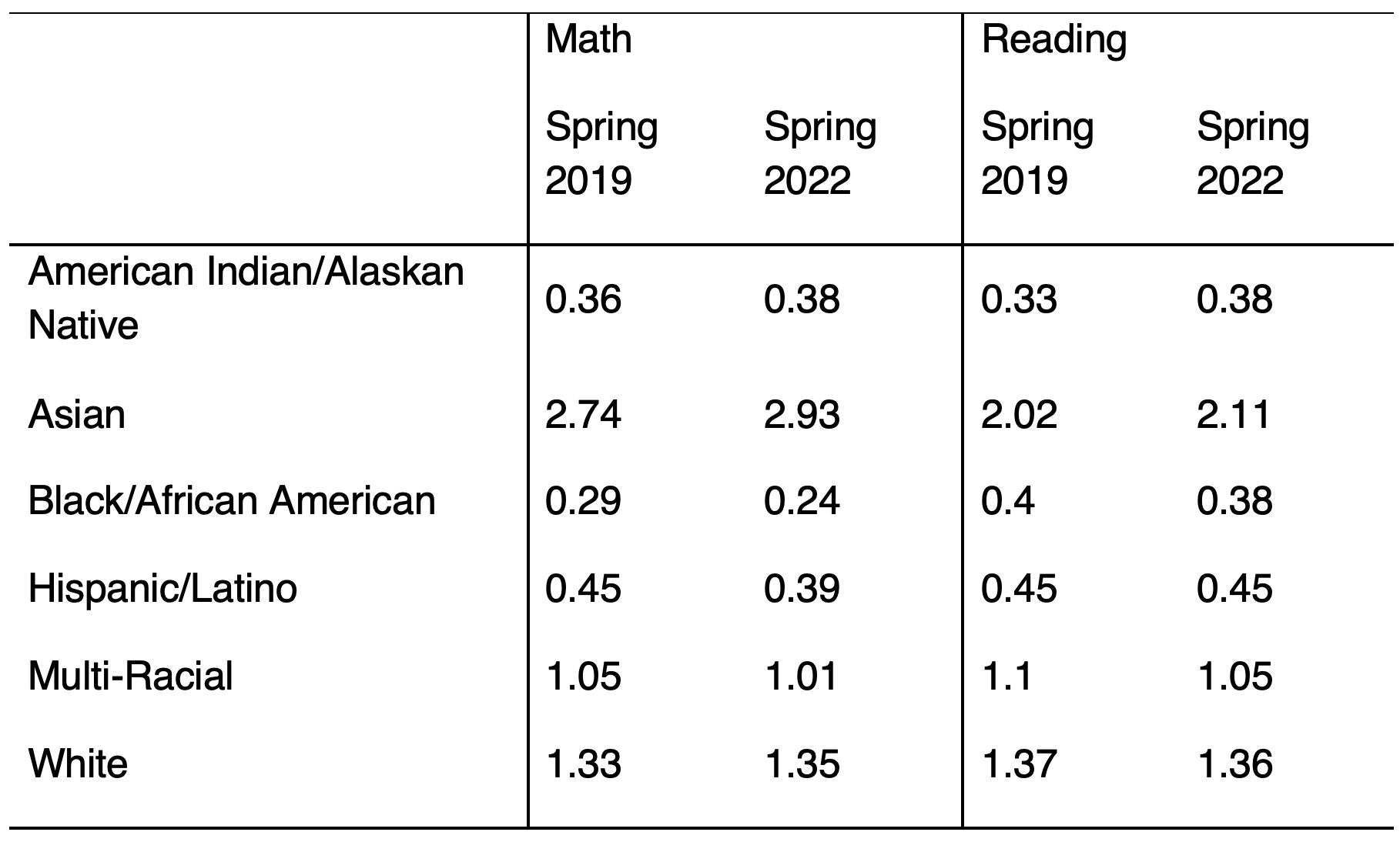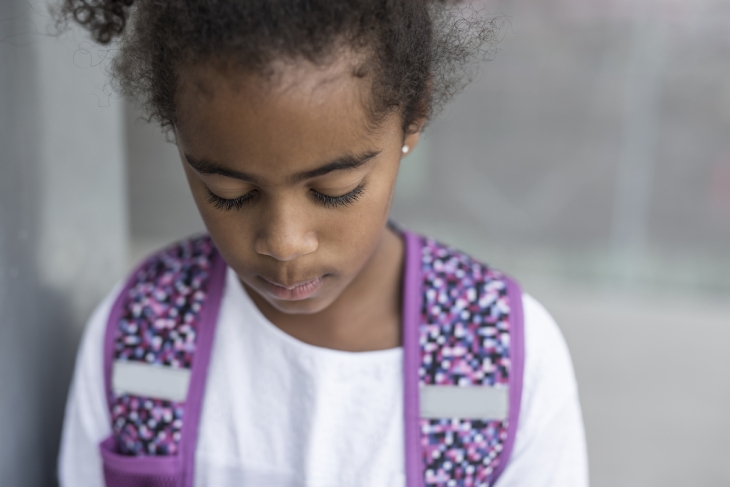By now the unfinished learning that resulted from the Covid-19 pandemic is old news. Compared to Spring 2019 levels, our colleagues Karyn Lewis and Megan Kuhfeld found that, in Spring 2022, same-grade students are scoring about 3–4 percentile rank points lower in reading and 5–10 percentile rank points lower in math. NAEP 2022 showed similar findings. Unfortunately, students of color and those attending high-poverty schools were harmed even more by the pandemic. Black and Hispanic third graders fell 6 percentile points in reading and 10 and 9 percentile points in math. The overall achievement distribution in the United States has shifted downward with students of color shifting even more than average.
As educators are now more aware of the scope and nature of unfinished learning, what’s also becoming apparent is the implications it has on many traditional policies and practices that were designed in a pre-pandemic world. A perfect example of such policies and practices are the identification and placement criteria for advanced learning opportunities, such as exam-based high schools, gifted and talented programs, or even individual courses like seventh-grade algebra. It might be intuitive to think that a drop in scores due to the pandemic will mean fewer students meeting traditional readiness benchmarks, and that’s likely true, but there are also important equity implications.
Many program placement or intervention criteria rely on predetermined cut scores or normative percentiles. Simply put, they identify students for placement if they score in the top or bottom X percent of a given normative sample or if they meet a given cut score (e.g., a MAP RIT score of 200). In states like Arizona, Oklahoma, Nevada, West Virginia, and Florida, students must meet certain national percentiles to be identified for gifted and talented programs. However, most if not all the normative samples to which students will be compared were collected before the pandemic. As a result, when schools give assessments during the 2022–23 school year, many of the test reports that schools and parents look at will include percentiles that contextualize scores based on pre-Covid performance.
Given the decrease in overall student achievement, schools that make advanced learning program placement decisions in 2022–23 (and beyond) are likely to see smaller and less-equitable student populations compared to prior years. To test this hypothesis and quantify the change, we dove into third grade MAP data from spring 2019 and spring 2022. We wanted to know how the demographic profile of students meeting the 90th percentile threshold (as established in the NWEA norms) in spring 2019 compared to that of those who met the same threshold in spring 2022. To do so we relied on something called a representation index (RI), which is the proportion of students from a particular demographic group within the 90th percentile group divided by their proportion in the overall student population. For example, if White students were 50 percent of those who scored at or above the 90th percentile, but 40 percent of the overall student population, this would yield an RI of 1.25 (0.50/0.40) and signify proportional overrepresentation within the 90th percentile. Our analyses relied on data from roughly 1.5 million students who completed a MAP Growth test in spring 2019 or spring 2022. The math results are presented visually in Figure 1 with the specific RI values for math and reading at the end of the article in Table 1.
Figure 1. Change in the 90th percentile representation index in math by race/ethnicity, 2019 and 2022

First, Figure 1 makes clear that even prior to the pandemic in 2019, there was already substantial inequity within the 90th percentile. For example, Table 1 shows Hispanic students were 45 percent as represented (RI = 0.45) as they were in the overall student population. Similarly, Asian students were 274 percent as represented as they were in the overall student population (RI = 2.74). Unfortunately, this only became worse after the pandemic. Figure 1 shows that, in spring 2022, the population of third grade students meeting the 90th percentile in math was less Black and Hispanic and more White and Asian than it was in Spring 2019. Black student representation decreased from a 2019 RI of 0.29 to a 2022 RI of 0.24—a drop of 20 percent. Hispanic students also become less represented—moving from an RI of 0.45 to 0.35 (a decrease of 15 percent). Meanwhile, White students (RI of 1.33 to 1.35) and Asian students (RI of 2.74 to 2.93) became even more overrepresented within the top 10 percent of math achievement. This trend was also present in reading (see Table 1) but was not as extreme as in math.
Importantly, just because fewer Black and Hispanic students scored at the 90th percentile does not mean they don’t need services. Talented students of color very much still exist, but because of the pandemic, the percentile their score represents is now lower. Consider a hypothetical student of color who would have scored at the 91st percentile, had Covid never happened, might now score at the 89th percentile. That’s a seemingly small change in the student’s achievement, but because they fell below a fixed threshold, they now don’t meet the criteria for a particular advanced learning opportunity and the small change becomes quite consequential, given many educational decisions are based on often-fixed, often-arbitrary percentile cut scores.
What does this mean for schools?
Around the country, K–12 gifted programs and exam-based high schools were already struggling with equity prior to the pandemic. A 2019 study found that students in the top 20 percent of socioeconomic status were identified as gifted at a rate of about 12 percent compared to just over 2 percent for their peers in the lowest 20 percent. Unfortunately, our analyses suggest that, when schools go to identify students for these opportunities in the 2022–23 school year, disproportional representation is likely to get worse. Although few advanced learning opportunities identify students solely based on a single data point (and we do not advise using MAP Growth scores alone to make such decisions), if our findings hold for other assessments and criteria, students of color will be identified for advanced learning opportunities at even lower rates than they were prior to the pandemic (and again, those were already very bad). Importantly, this is not something that is unique to any single test, nor does it represent a failure of any test. Instead, is it an artifact of a massive and unprecedented interruption in learning that was also experienced unequally by students from traditionally marginalized groups. Combined with the common practice of reliance on fixed and often inflexible cut scores for program admission, schools arrive at a perfect storm of inequity.
What should schools do?
One of the simplest ways schools could approach this challenge with an eye toward improving equity would to rely on district or school building norms to make such placement decisions using their most recent data. Conceptually, this means identifying students for advanced learning opportunities if they rank in the top X percent of students in their district or school as opposed to the top X percent of the nation. Doing so removes the influence of pre-Covid national norms from the equation, will make the proportion of students identified stable from year to year (and school to school), and will make the students identified more representative of the larger student population. School districts like New York City and Fairfax County (including Thomas Jefferson High School for Science and Technology), as well as the states of New Jersey and Illinois, have already implemented local normative criteria into their decision-making process prior to the pandemic. There are other conceptual and equity benefits to this practice, but their equity benefits alone make them worth considering.
Perhaps more importantly, schools should avoid the temptation to focus their Covid recovery efforts solely on minimal proficiency of grade-level standards. To be sure, struggling students require urgent intervention to recover from the pandemic. But ignoring the needs of advanced learners, particularly those of color or who are from low-income families, will only perpetuate pre-Covid inequalities in advanced learning opportunities. Instead, schools should see this as an opportunity to implement talent development activities that would mitigate these disparate rates of advanced achievement. Much attention is being paid to efforts to help students rebound from the pandemic. But if those efforts focus solely on rebounding to minimal proficiency, the worsening equity we describe above risks becoming a permanent fixture of American education.
Table 1. Representation indices for spring 2019 and spring 2022 by student subgroup

Editor’s note: This was also published as a guest article in an edition of “Advance,” a newsletter from the Thomas B. Fordham Institute written by Brandon Wright, our Editorial Director, and published every other week. Its purpose is to monitor the progress of gifted education in America, including legal and legislative developments, policy and leadership changes, emerging research, grassroots efforts, and more. You can subscribe on the Fordham Institute website and the newsletter’s Substack.


